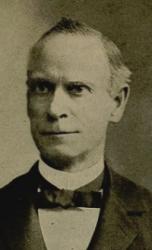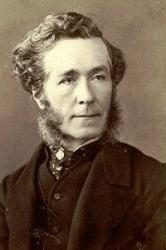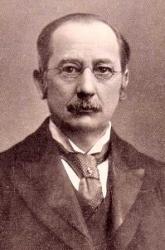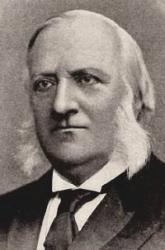Planning worship?
Check out our sister site, ZeteoSearch.org,
for 20+ additional resources related to your search.
- |
User Links
Person Results
Anonymous
Author of "Go when the morning shineth" in A Book of Hymns for Public and Private Devotion. (10th ed.) In some hymnals, the editors noted that a hymn's author is unknown to them, and so this artificial "person" entry is used to reflect that fact. Obviously, the hymns attributed to "Author Unknown" "Unknown" or "Anonymous" could have been written by many people over a span of many centuries.
Anonymous
Asa Hull

1828 - 1907 Composer of "[Go when the morning shineth]" in Gospel Praise Book. Asa Hull USA 1828-1907. Born in Keene, NY, he became a music publisher in New York City. He married Emma F Atherton, and they had a daughter, Harriett. He wrote many tunes and authored temperance rallying songs. He published 33 works, of which 21 were songbooks, between 1863-1895. He died in Philadelphia, PA.
John Perry
Asa Hull
Jane C. Simpson
1811 - 1886 Person Name: Jane Cross Simpson Author of "Go, when the morning shineth" in Hymn and Tune Book of the Methodist Episcopal Church, South (Round Note Ed.) Simpson, Jane Cross, née Bell, daughter of James Bell, Advocate, of Glasgow, was born Nov. 12, 1811. She contributed several pieces to The Edinburgh Literary Journal, of which her brother, Henry G. Bell, was editor, under the nom de plume of Gertrude; and later to the Scottish Christian Herald. She was married in 1837 to her cousin, Mr. J. B. Simpson, of Glasgow; and died June 17, 1886.
Her publications are:—(1) The Piety of Daily Life, 1836; (2) April Hours, 1838; (3) Woman's History, 1848; (4) Linda, or Beauty and Genius, 1859; (5) Picture Poems, 1879; (6) Linda, and other Poems, 1879.
Her hymns in common use are:—
1. Go when the morning shineth. Prayer. This appeared in The Edinburgh Literary Journal, Feb. 26, 1831, in 4 stanzas of 8 lines, and again in her April Hours, 1838, in 3 st. The full text from Mrs. Simpson's manuscript was given in Lyra Britannica, 1867, p. 507. It is extensively used. It is sometimes erroneously attributed to "Lord Morpeth;" and again to "Lord Carlisle."
2. I had a lesson to teach them. The Death of Children. Contributed to Dr. Rogers's Lyra Britannica, 1867, p. 508, in 9 stanzas of 4 lines. It was repeated in full in Martineau's Hymns, &c, 1873.
3. Star of morning, brightly shining. For use at Sea. Given in E. Prout's Psalmist, 1878.
4. Star of peace to wanderers weary. For those at Sea. Written in 1830, and given in the Scottish Evangelical Union Hymnal, 1878.
-- John Julian, Dictionary of Hymnology (1907)
Jane C. Simpson
John Hullah

1812 - 1884 Person Name: J. P. Hullah Composer of "BENTLEY" in The Y.M.C.A. Hymnal Born: June 27, 1812, Worcester, England.
Died: February 21, 1884, London, England.
John Hullah
Carrie B. Adams

1859 - 1940 Composer of "[Go, when the morning shineth]" in Songs for Children Adams, Carrie Belle (Wilson). (Oxford, Ohio, July 28, 1859-1940). Father, David Wilson, song writer, teacher of music. Married, 1880 to Allyn G. Adams, moved to Terre Haute, Indiana. Director and organist, First Congregational Church; Central Christian Church. Teacher (1887-1895), Indiana State Normal School. Wrote many anthems and cantatas, secular and religious, many published by Lorenz.
--Keith C. Clark, DNAH Archives
===================
Mrs. Carrie B. (Wilson) Adams was born in Oxford, Ohio, July 28, 1859. Her father, Mr. David Wilson, was author of a number of songs and books, also a singing teacher of note in his day, and her mother was quite musically inclined.
Her experience with her father in elementary and advanced class work, in children's and harmony classes, her years of musical participation in solo work and in accompanying, in the organization and leadership, not only of choirs, but also of great choral organizations, her close touch with singers of elementary grade, as well as those of great skill and reputation, have given her a breadth of musical thought and practical power of adaptation that constantly enrich her work of composition.
Miss Carrie B. Wilson became Mrs. Allyn G. Adams in 1880, and soon after located in Terre Haute, Ind., where her husband was a leading bass singer and interested in large commercial enterprises. Mrs. Adams soon became a leading figure in the musical life of that enterprising city, and has been actively identified with the Choral Club, Treble Clef Club, Rose Polytechnic Glee Club, First Congregational Church and Central Christian Church choirs, as director, chorister and organist. From 1887 to 1895 she occupied the chair of music in the Indiana State Normal School.
Her first anthem was published in 1876. Among her best known publications are four anthem books — "Anthem Annual, Nos. 1 and 2," and " Royal Anthems, Nos. 1 and 2" ; "Music for Common Schools"; two sacred cantatas, "Redeemer and King " and "Easter Praise" ; an operetta for church and school use, "The National Flower"; a group of Shakespeare songs from "As You Like it," and a large number of anthems,
male choruses, ladies' quartets and miscellaneous pieces in octavo form.
http://archive.org/stream/biographyofgospe00hall/biographyofgospe00hall_djvu.txt
Carrie B. Adams
F. A. Blackmer
1855 - 1930 Author (v. 3) of "Secret Prayer" in The Golden Sheaf No. 2 Blackmer, Francis Augustus. (Ware, Massachusetts, February 17, 1855--October 8, 1930, Somerville, Massachusetts). Advent Christian musician. His parents, Augustus and Jane Blackmer, were among those caught up in the excitement of the Millerite Movement. One son, Fred, became an Advent Christian minister. Francis, with a talent recognized at an early age, consecrated his own life to Christian service as a musician. He was immersed in baptism at the Adventist campmeeting in Springfield, Massachusetts, by Elder Miles Grant.
His early years were spend in central Massachusetts, his schooling at Wilbraham Academy. He was largely self-taught in harmony and musical composition. He wrote the words and music to his first gospel song, "Out on the fathomless sea," at the age of sixteen. Altogether he wrote over 300 gospel songs about the Second Coming, witnessing and working for the Lord, and praises to God's Holy Name. A few of these have circulated widely outside his own denomination. His final text, "I shall see him, And be like him," came when he was so weak that his friend, Clarence M. Seamans, had to supply the music. He used the pseudonym, A. Francis, with some of his early songs.
Blackmer's first anthology was The Gospel Awakening, (1888). Subsequent gospel songbooks with which he was associated were: Singing by the Way (1895), Carols of Hope (1906), The Golden Sheaf, No. 2 (1916), and Songs of Coming Glory (1926).
Most of his adult life was spent in Somerville, Massachusetts, a suburb of Boston, where he had a prosperous piano business. In the 1890s, his "Francis A. Blackmer Pianos" were made for him by the Washington Hall Piano Company of Boston. Later, his "Good as Gold Pianos" were manufactured by the Christman Piano Company of New York City and shipped directly to his customers throughout New England.
In Somerville, Blackmer served as choirmaster and song-leader in the Advent Christian Church for many years. He was also an elder of the church until his death. From 1914 until his death, he was songleader at the mid-summer Alton Bay Campmeeting on Lake Winnepesaukee, New Hapshire. There his High Rock Hill was both a salesroom and a summer cottage over the years. He was a member of the board of directors of the campmeeting association for several years. Very popular were his singing sessions on the campground square between suppertim and evening services, and a final sing into the small hours of the night following the final service of the campmeeting.
--Leonard Ellinwood, DNAH Archives
F. A. Blackmer
Evan Stephens
1854 - 1930 Composer of "[Go, when the morning shineth]" in Deseret Sunday School Songs Evan Stephens (1854-1930) was a Welsh composer, conductor, and teacher. Born in Pencader, Carmarthenshire, Wales, he emigrated to Salt Lake City, Utah in 1866. He directed the vocal music program at the University of Utah from 1885 to 1900, and directed the Mormon Tabernacle Choir from 1890 to 1916. Stephens is remembered for his many contributions to the cultural growth of the state of Utah, his leadership of the Mormon Tabernacle Choir, and for the numerous hymns and songs he composed. - from the Library of Congress authority file
Evan Stephens
Frederick Bridge

1844 - 1924 Person Name: J. F. Bridge Composer of "CRATHIE" in Chautauqua Hymnal and Liturgy Sir John Frederick Bridge CVO (5 December 1844 – 18 March 1924) was an English organist, composer, teacher and writer.
From a musical family, Bridge became a church organist before he was 20, and he achieved his ambition to become a cathedral organist by the age of 24, at Manchester Cathedral. After six years there, he was invited to become organist at Westminster Abbey, where he remained for the rest of his career. He instituted several changes to modernise and improve the music-making at the Abbey and organised the music for several state occasions, including two coronations.
As a teacher and lecturer, Bridge held posts at the Royal College of Music, Gresham College and the University of London. His students included the composers Arthur Benjamin and Noel Gay, the organists Edward Bairstow and Herbert Brewer, the conductor Landon Ronald and the early music pioneer Arnold Dolmetsch. His public lectures at Gresham College attracted large audiences, and they covered a wide range of subjects and musical periods.
For 25 years, Bridge was conductor of the Royal Choral Society, with whom he performed many new works, including some of his own compositions and works by the British composers Elgar, Vaughan Williams and Parry.
Bridge was born in Oldbury, then in Worcestershire, in central England, the eldest son of John Bridge and his wife, Rebecca née Cox. In 1850, his father was appointed a vicar-choral of Rochester Cathedral. Young Bridge was admitted to the cathedral choir as a "practising boy" (that is, a probationer). The choirboys were educated by another of the vicars-choral. The régime was severe in discipline and rudimentary in curriculum, but among the alumni of the choir school of this period were future organists of four English cathedrals and of Westminster Abbey. They included Bridge's younger brother Joseph, who eventually became organist of Chester Cathedral.
Bridge's first participated in a great national commemoration in 1852, when, aged eight, he was allowed to help toll the cathedral bell to mark the death of the Duke of Wellington. When Bridge was nine, he and his father were members of the choir assembled by Michael Costa for the opening of the Crystal Palace in June 1854. At the age of 14 Bridge left the cathedral choir and was apprenticed to John Hopkins, organist of Rochester Cathedral. While still studying under Hopkins, Bridge was appointed organist of the village church of Shorne in 1851, and the following year moved to Strood Parish Church.[2] From 1863 to 1867 he studied composition with John Goss, professor of harmony at the Royal Academy of Music. Bridge said in 1897, "Very happy and improving lessons they were and it is impossible for me to over-estimate the value of the instruction given by that dear, simple-minded musician."
In 1865 Bridge was appointed organist of Holy Trinity Church, Windsor. There he was encouraged and influenced by George Job Elvey, organist of St. George's Chapel, Windsor, and made many friends including John Stainer and the young Hubert Parry. During his time at Windsor, Bridge passed the examination for the Fellowship of the Royal College of Organists, in 1867, and took his Bachelor of Music degree at the University of Oxford.
After four years at Windsor, Bridge achieved his ambition to become a cathedral organist, successfully competing for the post at Manchester Cathedral.[3] He spent six years there from 1869, with his brother Joseph as his assistant. While at Manchester, he took his Doctor of Music degree at Oxford in 1874, and was professor of harmony at Owens College from 1872.
Under Bridge's leadership musical standards of the cathedral were improved, and the unsatisfactory old organ was replaced. The state of the existing instrument was described by The Manchester Guardian as "not only discreditable to Churchmen, but especially objectionable when existing in the cathedral church of a wealthy diocese.". The churchwarden, William Houldsworth gave £5,000, and a magnificent new instrument was built by Hill and Sons of London.
In 1875 the organist and master of the choristers at Westminster Abbey, James Turle, retired. Bridge was invited to succeed him. As Turle was permitted to retain his former title in retirement, Bridge was formally "Permanent Deputy-Organist of Westminster Abbey" until Turle's death in 1882, but he was effectively in sole charge from the outset. The Musical Times wrote:
The appointment of Dr. Bridge to the post of organist at Westminster Abbey … will be welcomed by all interested in the cause of church music. The improvement in the services at Manchester Cathedral since Dr. Bridge has held the position of organist, may be regarded as a proof that in the responsible office which he has now accepted he will do his utmost to advance the character of the music in the Abbey; and we sincerely hope that the Dean and Chapter will allow him that unlimited power over the choir which may enable him to raise it to the high state of efficiency which the public has a right to expect.
To the general public, Bridge became known for organising the music, and composing some of it, for great state occasions, notably Queen Victoria's jubilee (1887), Edward VII's coronation (1902), the national memorial service for Edward VII (1910), George V's coronation (1911), and the reinauguration of Henry VII's Chapel as the chapel of the Order of the Bath (1913). In the musical world he was known for his special commemorations of English composers of the past. The first was a celebration of Henry Purcell in 1895, marking the bicentenary of Purcell's death. Bridge presented Purcell's Te Deum "purged of the 18th century accretions which had overlaid it". Later commemorations were of Orlando Gibbons (1907), and Samuel Sebastian Wesley (1910).
Having worked successfully to have the organ at Manchester replaced, Bridge found himself obliged to do the same at the Abbey. He described the instrument he inherited as "a very old-fashioned affair". In 1884 the organ was completely rebuilt by Hill and Son to a very high specification.
When the National Training School for Music was set up in 1876 under Arthur Sullivan, Bridge was appointed professor of organ. When the school was reconstituted as the Royal College of Music in 1883 he was appointed professor of harmony and counterpoint. In 1890 he was elected Gresham professor of music at Gresham College, London, and in 1903 he was appointed professor of music at the University of London. According to Guy Warrack and Christopher Kent in the Grove Dictionary of Music and Musicians, "accounts of his teaching are not complimentary", but he was generally regarded as a highly successful lecturer, and Alcock's Oxford Dictionary of National Biography article states, "Because of his persuasive style and apt illustrations, his lectures drew large audiences." His pupils at the Royal College and the Abbey included Edward Bairstow, Arthur Benjamin, Herbert Brewer, Arnold Dolmetsch, Noel Gay, Lloyd Powell and Landon Ronald.
Bridge's enthusiasms were many and varied. His lectures at Gresham College were well known for the wide range of topics he covered. His articles for the musical press showed a similar variety; some examples are: "Purcell and Nicola Matteis"; "Samuel Pepys – A Lover of Musicke"; "A Seventeenth Century View of Musical Education"; and "The Musical Cries of London in Shakespeare's Time". In 1899 he was a pioneer of authentic performance of Handel's score for Messiah, purging it of 18th and 19th century reorchestrations.
Bridge was the conductor of the Royal Choral Society from 1896 to 1921. In an article celebrating his work with the society, Herman Klein listed the new works that it had performed under Bridge's baton. They included six works by Elgar, four apiece by Parry, Stanford, and Samuel Coleridge-Taylor, and works by Alexander Mackenzie, Frederick Cowen, Hamilton Harty, Ethel Smyth and Vaughan Williams.
Bridge was married three times, first, in 1872, to Constance Ellen Moore (d. 1879); second, in 1883, to Helen Mary Flora Amphlett (d. 1906), and third, in 1914, to Marjory Wedgwood Wood (d. 1929). There were a son and a daughter of the first marriage, and a daughter of the second. Bridge was knighted in 1897, and created MVO in 1902 and CVO in 1911. He was awarded honorary degrees from the universities of Durham (1905) and Toronto (1908).
Bridge retired as organist of the Abbey in 1918, but was granted the title of "Organist Emeritus" and continued to live in the Little Cloisters until his death six years later at the age of 79. His funeral took place at Glass, Aberdeenshire, where he was buried on 21 March 1924.
--en.wikipedia.org/wiki/ (excerpts)
Frederick Bridge
J. H. Leslie
Person Name: H. J. Leslie Composer of "[Go when the morning shineth]" in The School Hymnal
J. H. Leslie
George M. Garrett

1834 - 1897 Person Name: George Mursell Garrett (1834- ) Composer of "GENESIS" in Carmina for the Sunday School and Social Worship Born: June 8, 1834, Winchester, Hampshire, England.
Died: April 9, 1897, Cambridge, England.
Buried: Cambridge Mill Road Cemetery, Cambridge, England
George M. Garrett


 My Starred Hymns
My Starred Hymns


